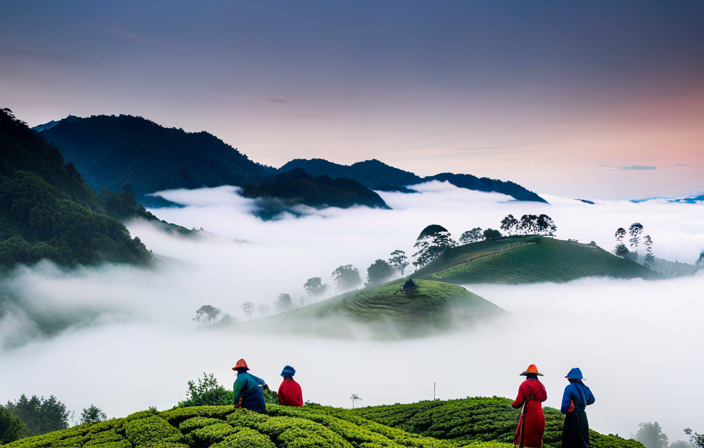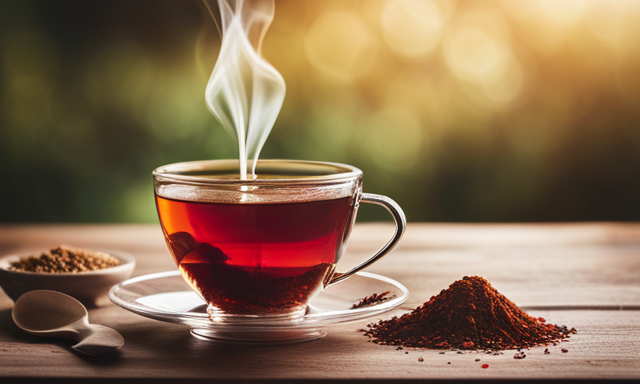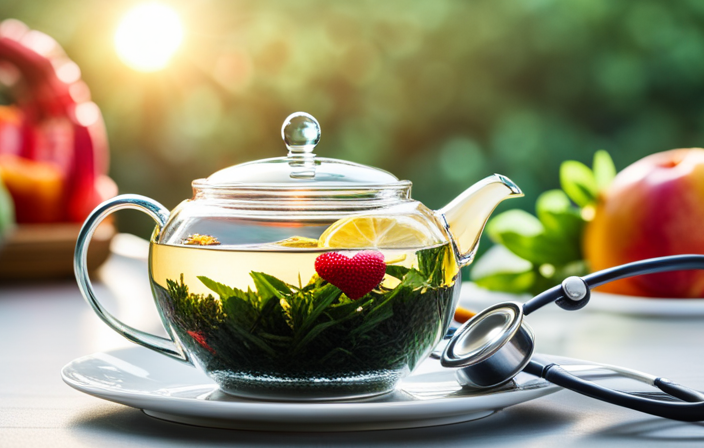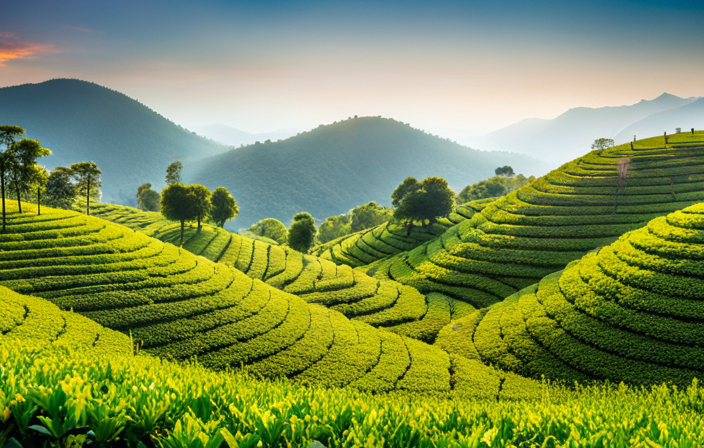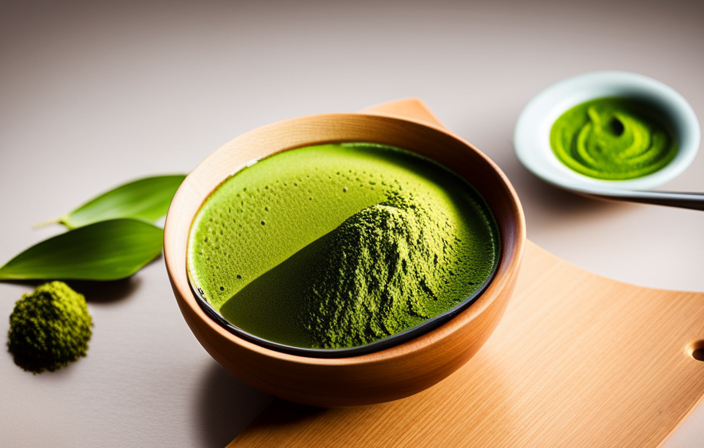As a tea enthusiast, I often find myself pondering what makes a country stand out as a top tea producer. It’s fascinating to think that a combination of factors, such as cultivation processes, quality of tea leaves, unique varieties, tradition, climate, and industry standards, contribute to a nation’s reputation in the tea industry.
This article delves into the analytical side of tea production, exploring the data and industry-focused insights behind the recognition of top tea-producing countries. Let’s dive in and unravel the complexities of this captivating world.
Key Takeaways
- Soil quality and cultivation techniques play a crucial role in determining the taste and aroma of tea, and different tea varieties thrive in different soil types.
- Leaf grading, expert cultivation and processing, and tea auctions are important factors in establishing a country’s reputation as a top tea producer.
- A country’s reputation as a top tea producer leads to increased demand and higher prices, contributing to overall economic growth.
- The preservation of tea-making techniques and adherence to industry standards and regulations are essential for maintaining consistent quality and ensuring the safety of tea products.
Cultivation Processes: The Key to Exceptional Tea Production
I love learning about the cultivation processes that are the key to exceptional tea production. Cultivation techniques play a crucial role in determining the quality and flavor profiles of teas.
One of the most important factors in tea cultivation is soil quality. The composition of the soil affects the nutrient content of the tea plants and ultimately impacts the taste and aroma of the final product. Tea plants require well-drained soil with good fertility and a balanced pH level. Different tea varieties thrive in different soil types, such as the acidic soil preferred by Camellia sinensis var. sinensis in China.
Soil testing and analysis are essential to ensure the optimal conditions for tea cultivation. By understanding and implementing proper cultivation techniques, tea producers can maximize the potential of their plants and deliver exceptional teas to their customers.
Quality of Tea Leaves: How It Impacts a Country’s Reputation
When it comes to tea production, the quality of the tea leaves plays a crucial role in shaping a country’s reputation as a top tea producer. High-quality tea leaves not only bring a distinctive flavor profile but also showcase the expertise and care put into cultivation and processing.
A country known for producing exceptional tea leaves can attract tea enthusiasts and connoisseurs, influencing the demand and market value of their teas.
Leaf Quality and Reputation
During my research, I discovered that leaf quality and reputation play a crucial role in determining a country’s position as a top tea producer.
The quality of tea leaves is assessed through a process called leaf grading, which evaluates factors such as leaf appearance, aroma, and infusion.
Tea auctions are where these graded tea leaves are bought and sold, and they serve as a platform for producers to showcase their quality and establish their reputation in the industry.
By consistently producing high-quality tea leaves and maintaining a strong reputation, a country can attract buyers and establish itself as a top tea producer.
This recognition not only leads to increased demand and higher prices for their tea, but also influences the overall tea market by setting industry standards and raising the bar for quality.
Influence on Tea Market
The quality of tea leaves directly influences a country’s reputation and, consequently, its impact on the tea market. When it comes to tea exports, the market demand is greatly influenced by the reputation of a country as a top tea producer. A country renowned for its high-quality tea leaves will naturally attract more buyers and command higher prices in the market. This can have a significant influence on the country’s tea exports and overall economic growth. To illustrate this, let’s take a look at the following table:
| Country | Reputation | Market Demand |
|---|---|---|
| Country A | Excellent | High |
| Country B | Good | Medium |
| Country C | Average | Low |
As seen in the table, a country with an excellent reputation for producing high-quality tea leaves, like Country A, will experience higher market demand compared to countries with lower reputations. This showcases the influence of leaf quality on a country’s tea exports and market position.
Transitioning into the subsequent section, let’s explore how unique tea varieties can further enhance a nation’s tea diversity and reputation.
Unique Tea Varieties: Showcasing a Nation’s Tea Diversity
I’ve discovered a fascinating assortment of tea varieties that highlight the diverse flavors and rich cultural heritage of a nation’s tea production. Tea tasting events and tea festivals provide excellent opportunities to explore these unique flavors and gain insights into the world of tea.
These events not only showcase the different types of tea but also celebrate the traditions and customs associated with tea production. They allow tea enthusiasts to engage with experts, learn about the intricate tea-making processes, and experience the distinct characteristics of each variety.
Additionally, tea festivals provide a platform for tea producers to showcase their products, promote their brands, and connect with potential customers. The popularity of these events has grown significantly in recent years, attracting both local and international visitors who are eager to immerse themselves in the world of tea and discover new and exciting flavors.
Tradition and Heritage: Preserving Tea-Making Techniques
Preserving tradition and heritage is crucial in ensuring that tea-making techniques are passed down through generations and upheld for future tea enthusiasts. Tea has deep cultural significance and the techniques used to produce it are an integral part of a country’s identity. Here are three reasons why preserving tea-making techniques is essential:
-
Cultural significance: Tea-making techniques are often closely tied to a country’s history, customs, and rituals. By preserving these techniques, we can honor and celebrate the rich cultural heritage associated with tea.
-
Authenticity and quality: Traditional tea-making techniques have been refined over centuries and are known for producing high-quality teas. By preserving these techniques, we can ensure that the teas we enjoy are authentic and of the highest standard.
-
Sustainability: Many traditional tea-making techniques are rooted in sustainable practices that respect the environment and promote biodiversity. By preserving these techniques, we can contribute to the sustainability of the tea industry and protect our natural resources.
Preserving tea-making techniques isn’t only about preserving a craft; it’s about preserving a cultural legacy and ensuring that future generations can experience the true essence of tea.
Climate and Geography: Influencing Tea Growth and Flavor
Growing up in regions with diverse climates and unique geographical features, I’ve witnessed firsthand how they influence the growth and flavor profiles of teas. The climate and geography of a tea-growing region play a crucial role in determining the taste and quality of the tea produced. For example, high altitudes and cool temperatures result in slower growth and increased concentration of flavor compounds, leading to teas with more complex and robust flavors. On the other hand, low-lying areas with warmer climates produce teas that are lighter and more delicate in flavor. To illustrate this point, consider the table below, which highlights the influence of climate and geography on tea flavor and production:
| Climate/Geography | Flavor Profile | Tea Production |
|---|---|---|
| High altitude | Robust, complex | Slow, limited |
| Low altitude | Delicate, light | Abundant, fast |
Understanding the impact of climate and geography on tea flavor is essential for tea producers to maintain consistency and excellence in their products. By adapting cultivation techniques to suit the specific conditions of their region, producers can ensure that their teas consistently exhibit the desired flavor profiles. This attention to industry standards and regulations guarantees that tea lovers around the world can enjoy a consistently excellent cup of tea, regardless of its country of origin.
Industry Standards and Regulations: Ensuring Consistency and Excellence
As a tea enthusiast, I understand the importance of adhering to industry standards and regulations to ensure the consistent quality and excellence of tea products. Regulatory compliance plays a crucial role in maintaining the integrity of the tea industry.
Here are some key factors to consider:
-
Quality control: Industry standards dictate the proper methods for growing, harvesting, and processing tea. These standards ensure that tea leaves are handled and processed in a way that preserves their flavor and health benefits.
-
Safety measures: Adhering to regulatory guidelines helps tea producers implement food safety protocols, such as proper handling and storage practices. This ensures that tea products are safe for consumption and free from contaminants.
-
Sustainability practices: Industry standards often include guidelines for environmentally sustainable tea production. These practices promote responsible land use, water conservation, and biodiversity preservation.
Frequently Asked Questions
How Long Does It Take for Tea Plants to Reach Maturity and Produce High-Quality Leaves?
It takes several years for tea plants to reach maturity and produce high-quality leaves. Factors such as climate, soil quality, and cultivation techniques play a crucial role in this process.
Tea plants typically require around three to five years of growth before they can yield leaves suitable for tea production. During this time, the plants undergo various stages of development, including root establishment, leaf growth, and the accumulation of compounds that contribute to the desired taste and aroma of the final product.
Are There Any Specific Regions or Countries Known for Producing Exceptional Tea Despite Not Having Ideal Climate and Geography for Tea Cultivation?
When it comes to exceptional tea production, some regions or countries stand out despite not having ideal climate or geography. This can be attributed to specific tea varieties grown in non-traditional regions and the impact of cultural practices on tea production.
What Are Some Traditional Tea-Making Techniques That Have Been Passed Down Through Generations in Certain Countries?
Traditional tea-making techniques have been passed down through generations in certain countries, contributing to their cultural preservation and historical significance. These techniques play a crucial role in tea ceremonies, which are deeply rooted in the traditions and customs of these countries.
How Do Industry Standards and Regulations Ensure That Tea Produced in Different Countries Maintains Consistent Quality and Excellence?
Import/export regulations and certification standards play a crucial role in ensuring consistent quality and excellence in tea production worldwide. These regulations help countries maintain high standards by setting guidelines for cultivation, processing, packaging, and labeling.
Certification standards ensure that tea meets specific quality criteria and is free from contaminants. By adhering to these regulations and standards, countries can establish themselves as top tea producers, gaining recognition for their commitment to quality and excellence in the industry.
Can a Country’s Reputation as a Top Tea Producer Be Solely Based on the Quality of Its Tea Leaves, or Are There Other Factors That Contribute to Its Recognition?
A country’s reputation as a top tea producer isn’t solely based on the quality of its tea leaves. Other factors contribute to its recognition, such as cultural significance and economic impact.
Cultural significance plays a crucial role as a country’s tea culture reflects its traditions, rituals, and expertise in tea production. The way tea is grown, harvested, and prepared can vary greatly from one country to another, and these unique practices contribute to a country’s reputation as a top tea producer. The tea ceremonies and rituals associated with tea consumption also play a significant role in a country’s cultural identity and can enhance its reputation as a top tea producer.
Additionally, the tea industry plays a significant role in a country’s economy and global trade. The production and export of tea can create jobs and generate revenue for a country. Many countries rely on tea production as an important sector of their economy, and being recognized as a top tea producer can attract foreign investments and boost exports. The economic impact of the tea industry, therefore, contributes to a country’s recognition as a top tea producer.
These factors collectively contribute to a country being recognized as a top tea producer. The quality of tea leaves, cultural significance, and economic impact are all interconnected and influence a country’s reputation in the global tea market.
Conclusion
In conclusion, the factors that contribute to a country being recognized as a top tea producer are:
- Cultivation processes
- Quality of tea leaves
- Unique tea varieties
- Tradition and heritage
- Climate and geography
- Industry standards and regulations
These elements work together harmoniously to create exceptional tea production, showcasing a nation’s tea diversity and ensuring consistency and excellence.
Like a well-steeped cup of tea, the success of a top tea producer is a blend of meticulous craftsmanship, rich flavors, and a deep-rooted tradition.

